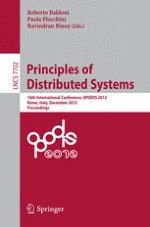2012 | OriginalPaper | Buchkapitel
When and How Process Groups Can Be Used to Reduce the Renaming Space
verfasst von : Armando Castañeda, Michel Raynal, Julien Stainer
Erschienen in: Principles of Distributed Systems
Verlag: Springer Berlin Heidelberg
Aktivieren Sie unsere intelligente Suche, um passende Fachinhalte oder Patente zu finden.
Wählen Sie Textabschnitte aus um mit Künstlicher Intelligenz passenden Patente zu finden. powered by
Markieren Sie Textabschnitte, um KI-gestützt weitere passende Inhalte zu finden. powered by
Considering the
M
-renaming problem and process groups, this paper investigates the following question: Is there a relation between the number of groups and the size of the new name space
M
? This question can be rephrased as follows: Can the initial partitioning of the processes into
m
groups allows the size of the renaming space
M
to be reduced, and if yes, how much?
This paper answers the previous questions. Let
n
denote the number of processes. Assuming that the processes are initially partitioned into
m
=
n
− ℓ non-empty groups, such that each process knows only its identity and its group number, the paper first presents a wait-free
M
-renaming algorithm whose size of the new name space is
M
=
n
+ 2ℓ − 1. For
$\frac{n}{2} < m \leq n-1$
(i.e.
$1\leq \ell < \frac{n}{2}$
), we have
M
< 2
n
− 1, which shows that, when the number of groups is greater than
$\frac{n}{2}$
, groups allow to circumvent the renaming lower bound in read/write systems. Then, on the lower bound size, the paper shows that there are pairs of values (
n
,
m
) such that there is no read/write wait-free
M
-renaming algorithm for which
M
≤ 2
n
− 2. This impossibility result breaks our hope to have a renaming algorithm providing a new name space whose size would decrease “regularly” as the number of groups increases from 1 to
n
. Finally, the paper considers the case where each group includes at least
s
processes. This algorithm shows that, when
m
is such that
$\frac{n}{s+1}< m < \frac{n}{s}$
, there is an
M
-renaming algorithm where
M
= 3
n
− (
s
+ 1)
m
− 1 =
n
(2 −
s
) + (
s
+ 1)ℓ − 1. Hence, the paper leaves open the following question: For any
n
and
s
= 1, does the predicate
$m > \frac{n}{2}$
define a threshold on the number of groups which allows the 2
n
− 2 lower bound on the renaming space size to be bypassed?
